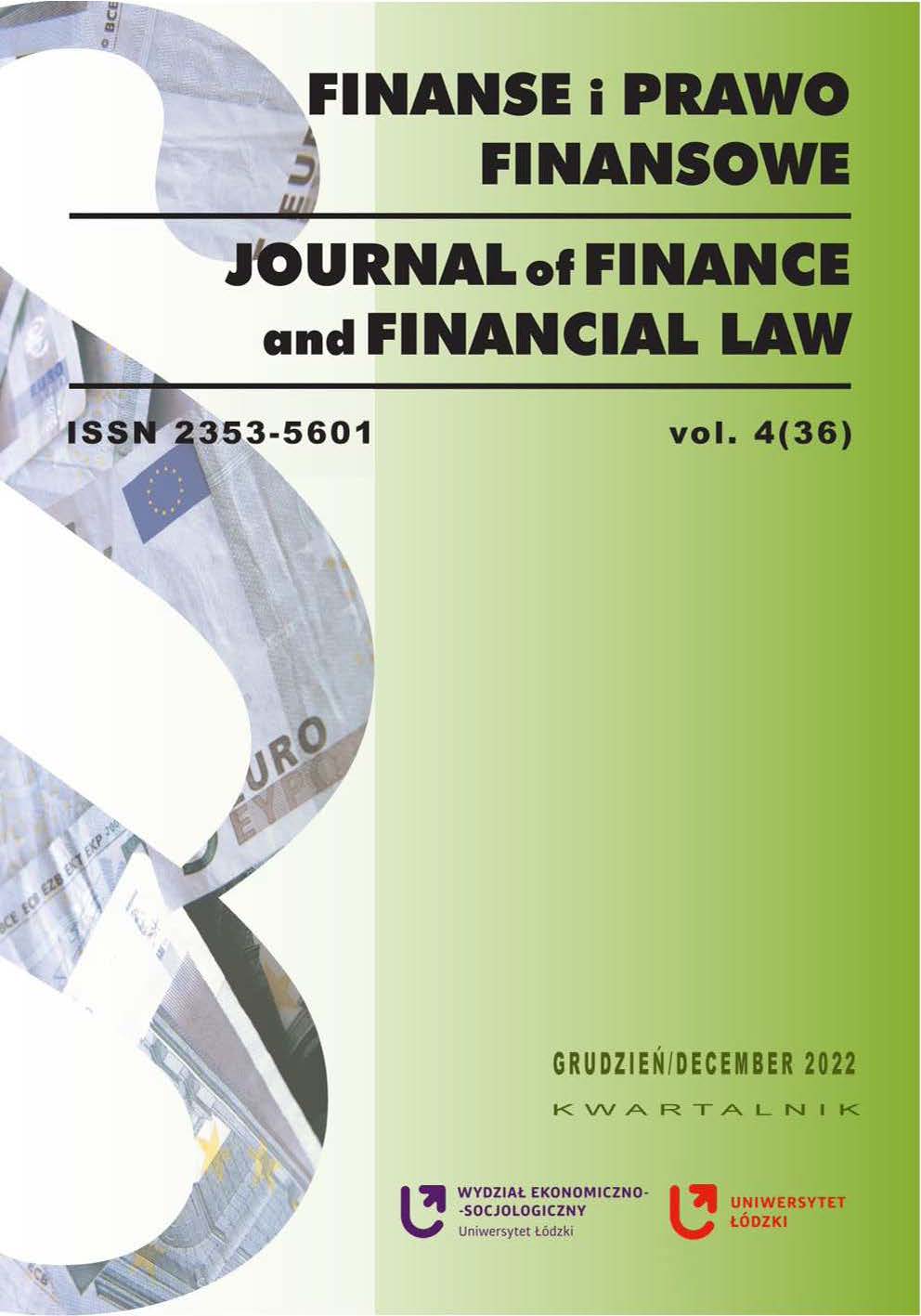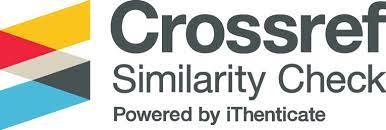The Issue Price in the Initial Public Offering and the Reasons for Excluding the Company from NewConnect
DOI:
https://doi.org/10.18778/2391-6478.4.36.02Keywords:
NewConnect, initial public offering, Alternative Trading System, delisting, issue priceAbstract
The purpose of the article. The subject of this article is the analysis of the change in the share price on the day of the company's debut on the NewConnect market due to the reasons for its exclusion from trading. The analysis was carried out for all companies debuting on NewConnect in 2007–2020. The results are presented depending on the share issue price. The paper hypothesized that companies whose share issue price was incorrectly estimated, which means overvalued or undervalued IPO, are more often withdrawn from the NewConnect market.
Methodology. The research was carried out using the analysis of source data. In the research process, the author used, in addition to the analysis of the literature, the method of observation.
Results of the research. As a result of the research, it was found that 39.84% of companies that debuted on the NewConnect market in 2007–2020 were excluded from trading. 56.28% of the withdrawn companies were forcibly excluded. On the other hand, 108 companies were withdrawn from trading voluntarily, and the prevailing premise in this group of entities was the transfer of the company to the WSE Main Market. Voluntary reasons prevail among entities withdrawn from trading, whose shares had an issue price of PLN 5 and higher. On the other hand, in the group of "penny" companies, the main reason for delisting is the safety of trading and liquidation bankruptcy. An increase in the share price on the debut day was recorded in 69.64% of entities withdrawn from NewConnect. The adopted hypothesis was positively verified. Companies whose share issue price was not properly estimated were withdrawn from the NewConnect market more often than entities whose securities price did not change on the day of their debut. The level of withdrawn companies whose IPO was overvalued and undervalued is similar. The conducted research proves that among overvalued initial public offerings, the share of voluntary reasons for withdrawal prevails, while among undervalued ones there is a higher share of forcibly excluded entities. However, the amount of the issue price according to the ranges adopted in the study does not constitute a premise for the withdrawal of companies from the NewConnect market.
Downloads
References
Algebaly, E.-A. M., Ibrahim, Y. and Ahmad-Zaluki, N.A. (2014). The determinants of involuntary delisting rate in the Egyptian stock market. Review of Accounting and Finance, 13(2). https://doi.org/10.1108/RAF-04-2012-0035
Google Scholar
DOI: https://doi.org/10.1108/RAF-04-2012-0035
Bakke, T.-E., Jens, C. and Whited, T. (2012). The real effects of delisting: Evidence from a regression discontinuity design. Finance Research Letters, 9(4). https://doi.org/10.1016/j.frl.2012.08.002
Google Scholar
DOI: https://doi.org/10.1016/j.frl.2012.08.002
Ball, R. and Shivakumar, L. (2008). Earnings quality at initial public offerings. Journal of Accounting and Economics, 45(2–3). https://doi.org/10.1016/j.jacceco.2007.12.001
Google Scholar
DOI: https://doi.org/10.1016/j.jacceco.2007.12.001
Bancel, F. and Mittoo, U.R. (2009). Why do European firms go public? European Financial Management, 15. https://doi.org/10.1111/j.1468-036X.2009.00501.x
Google Scholar
DOI: https://doi.org/10.1111/j.1468-036X.2009.00501.x
Baron, D.P. (1982). A Model of the Demand for Investment Banking Advising and Distribution, Services for New Issues. Journal of Finance, 37. https://doi.org/10.2307/2327760
Google Scholar
DOI: https://doi.org/10.1111/j.1540-6261.1982.tb03591.x
Beaver, W., McNichols, M. and Price, R. (2007). Delisting returns and their effect on accounting based market anomalies. Journal of Accounting and Economics, 43(2). https://dx.doi.org/10.2139/ssrn.2412547
Google Scholar
DOI: https://doi.org/10.1016/j.jacceco.2006.12.002
Bessler, W., Kaen, F., Kurmann, P. and Zimmermann, J. (2012). The listing and delisting of german firms on NYSE and NASDAQ: Were there any benefits? Journal of International Financial Markets, Institutions and Money, 22(4). https://doi.org/10.1016/j.intfin.2012.01.001
Google Scholar
DOI: https://doi.org/10.1016/j.intfin.2012.01.001
Bessler, W., Beyenbach, J., Rapp, M.S. and Vendrasco, M. (2022). Why do firms down-list or exit from securities markets? Review of Managerial Science, Working paper. https://doi.org/10.1007/s11846-022-00554-4
Google Scholar
DOI: https://doi.org/10.1007/s11846-022-00554-4
Bharath, S.T., Dittmar, A.K. (2010). Why do firms use private equity to opt out of public markets? Review of Financial Studies, 23. https://doi.org/10.1093/rfs/hhq016
Google Scholar
DOI: https://doi.org/10.1093/rfs/hhq016
Bhabra, H. and Pettway, R. (2003). IPO prospectus information and subsequent performance. Financial Review, 38(3). https://doi.org/10.1111/1540-6288.00051
Google Scholar
DOI: https://doi.org/10.1111/1540-6288.00051
Bolek, M., Pluskota, A. and Wolski, R. (2021). Liquidity – Profitability Trade-Off on the Example of Companies Listed on Main and Alternative New Connect Markets on Warsaw Stock Exchange. Finanse i Prawo Finansowe, 4(28). https://doi.org/10.18778/2391-6478.4.28.02
Google Scholar
DOI: https://doi.org/10.18778/2391-6478.4.28.02
Briston, R. and Jelic, R. (2003). Privatisation Initial Public Offerings: The Polish Experience. European Financial Management, 9(4). https://doi.org/10.1111/1468-036X.00232
Google Scholar
DOI: https://doi.org/10.1111/1468-036X.00232
Buszko, M. and Kołosowska, B. (2013). Przechodzenie spółek z alternatywnego systemu obrotu NewConnect na rynek regulowany GPW – cele, uwarunkowania, efekty. Zeszyty Naukowe Uniwersytetu Szczecińskiego. Ekonomiczne Problemy Usług, 102.
Google Scholar
Clyde, P., Schultz, P. and Zaman, M. (1997). Trading Costs and Exchange Delisting: The Case of Firms That Voluntarily Move from the American Stock Exchange to the Nasdaq. The Journal of Finance, 52(5). https://doi.org/10.1111/j.1540-6261.1997.tb02753.x
Google Scholar
DOI: https://doi.org/10.1111/j.1540-6261.1997.tb02753.x
Cornanic, A. and Novak, J. (2015). Signaling by Underpricing the Initial Public Offerings of Primary Listings in an Emerging Market. Czech Journal of Economics and Finance, 65(4).
Google Scholar
DeAngelo, H., DeAngelo, A. and Rice, E. (1984). Going private: minority freeze outs and stockholder wealth. Journal of Law and Economics, 27.
Google Scholar
DOI: https://doi.org/10.1086/467070
Dewenter, K., Kim, C.-S. and Novaes, W. (2010). Anatomy of a regulatory race to the top: Changes in delisting rules at Korea’s two stock exchanges, 1999–2002. Journal of Corporate Finance, 16(4).
Google Scholar
DOI: https://doi.org/10.1016/j.jcorpfin.2010.06.005
Engelen, P.-J., Meoli, M., Signori, A. and Vismara, S. (2020). The effects of stricter regulation on the going public decision of small and knowledge-intensive firms. Journal Business Finance & Accounting, 47. https://doi.org/10.1111/jbfa.12417
Google Scholar
DOI: https://doi.org/10.1111/jbfa.12417
Fijałkowska, D., Muszyński, M. and Pauka, M. (2013). Zjawisko undepricingu na rynku NewConnect. Zeszyty Naukowe Uniwersytetu Szczecińskiego. Finanse. Rynki Finansowe. Ubezpieczenia, 766(62).
Google Scholar
Frydrych, S. (2021). Przyczyny wykluczenia spółek z rynku NewConnect. Studia Prawno-Ekonomiczne, CXX. https://doi.org/10.26485/SPE/2021/120/9
Google Scholar
DOI: https://doi.org/10.26485/SPE/2021/120/9
Frydrych, S. (2021). Sanctions as a Mechanism Disciplining Issuers on the NewConnect Market. European Research Studies Journal, XXIV(3B). https://doi.org/10.35808/ersj/2475
Google Scholar
DOI: https://doi.org/10.35808/ersj/2475
Frydrych, S. (2022). IPO Underpricing a wysokość ceny emisyjnej na rynku NewConnect. Studia Prawno-Ekonomiczne, CXXIII. https://doi.org/10.26485/SPE/2022/123/5
Google Scholar
DOI: https://doi.org/10.26485/SPE/2022/123/5
Kim, W. and Weisbach, M.S. (2008). Motivations for public equity offers: An international perspective. Journal of Financial Economics, 87.
Google Scholar
DOI: https://doi.org/10.1016/j.jfineco.2006.09.010
Kooli, M. and Meknassi, S. (2007). The survival of US IPO issuers: 1985–2005. Journal of Wealth Management, 10(2).
Google Scholar
DOI: https://doi.org/10.3905/jwm.2007.690955
Leuz, C., Triantis, A. and Wang, T.Y. (2008). Why do firms go dark? Causes and economic consequences of voluntary SEC deregistrations. Journal of Accounting & Economics, 45.
Google Scholar
DOI: https://doi.org/10.1016/j.jacceco.2008.01.001
Levis, M. (1990), The Winner’s Curse Problem, Interest Costs, and the Underpricing of Initial Public Offerings. Economic Journal, 100.
Google Scholar
DOI: https://doi.org/10.2307/2233595
Loughran, T. and Ritter, J.R. (1995). The new issues puzzle. Journal of Finance, 50(1). https://doi.org/10.1111/j.1540-6261.1995.tb05166.x
Google Scholar
DOI: https://doi.org/10.1111/j.1540-6261.1995.tb05166.x
Macey, J., O’Hara, M. and Pompilio, D. (2008). Down and out in the stock market: the law and economics of the delisting proces. Journal of Law and Economics, 51(4). https://dx.doi.org/10.1086/593386
Google Scholar
DOI: https://doi.org/10.1086/593386
Martinez, I. and Serve, S. (2016). Reasons for delisting and consequences: A literature review and research agenda. Journal of Economic Surveys, 31(3). https://doi.org/10.1111/joes.12170
Google Scholar
DOI: https://doi.org/10.1111/joes.12170
Mosionek-Schweda, M. (2013). Koszty i korzyści transferu spółki z NewConnect na rynek regulowany GPW SA. Zeszyty Naukowe Uniwersytetu Szczecińskiego. Finanse, Rynki Finansowe, Ubezpieczenia, 736.
Google Scholar
Pagano, M., Panetta, F. and Zingales, L. (1998). Why do companies go public? An empirical analysis. Journal of Finance, 53. https://doi.org/10.1111/0022-1082.25448
Google Scholar
DOI: https://doi.org/10.1111/0022-1082.25448
Pour, E.K. and Lasfer, M. (2013). Why do companies delist voluntarily from the stock market? Journal of Banking and Finance, 37(12), https://doi.org/10.1016/j.jbank-fin.2013.08.022
Google Scholar
DOI: https://doi.org/10.1016/j.jbankfin.2013.08.022
Regulamin Alternatywnego Systemu Obrotu, wraz z załącznikami, w brzmieniu przyjętym Uchwałą Nr 147/2007 Zarządu Giełdy z dnia 1 marca 2007 r., z późn. zm.
Google Scholar
Ritter, J.R. (1987). The Costs of Going Public. Journal of Financial Economics, 19.
Google Scholar
DOI: https://doi.org/10.1016/0304-405X(87)90005-5
Ritter, J.R. (1991). The long-run performance of initial public offerings. Journal of Finance, 46(1). https://doi.org/10.1111/j.1540-6261.1991.tb03743.x
Google Scholar
DOI: https://doi.org/10.1111/j.1540-6261.1991.tb03743.x
Sanger, G. and Peterson, J. (1990). An empirical analysis of common stock delistings. Journal of Financial and Quantitative Analysis, 25(2). https://doi.org/10.2307/2330828
Google Scholar
DOI: https://doi.org/10.2307/2330828
Śliwiński, P. and Woźniak, S. (2021). Koszty obecności spółki na rynku NewConnect i ich postrzeganie przez emitentów. Ruch Prawniczy, Ekonomiczny i Socjologiczny, 83(4). https://doi.org/10.14746/rpeis.2021.83.4.11
Google Scholar
DOI: https://doi.org/10.14746/rpeis.2021.83.4.11
Teoh, S.H., Welch, I. and Wong, T.J. (1998). Earnings management and the long‐run market performance of initial public offerings. The Journal of Finance, 53(6). https://doi.org/10.1111/0022-1082.00079
Google Scholar
DOI: https://doi.org/10.1111/0022-1082.00079
Ustawa z dnia 29 lipca 2005 r. o ofercie publicznej i warunkach wprowadzania instrumentów finansowych do zorganizowanego systemu obrotu oraz o spółkach publicznych Dz.U. 2005, nr 184, poz. 1539.
Google Scholar
You, L., Parhizgari, A. and Srivastava, S. (2012). Cross-listing and subsequent delisting in foreign markets. Journal of Empirical Finance, 19(2), https://doi.org/10.1016/j.jempfin.2011.11.005
Google Scholar
DOI: https://doi.org/10.1016/j.jempfin.2011.11.005
Yung, C., Çolak, G. and Wang, W. (2008). Cycles in the IPO market. Journal of Financial Economics, 89(1). http://dx.doi.org/10.2139/ssrn.972429
Google Scholar
DOI: https://doi.org/10.1016/j.jfineco.2007.06.007
Zasępa, P. (2013). Wpływ ceny nominalnej akcji na niedowartościowanie pierwszej oferty publicznej na rynku NewConnect. Prace Naukowe Akademii im. Jana Długosza w Częstochowie. Pragmatates Oikonomias, 7.
Google Scholar
Zygmanowski, P. (2015). Wpływ zmiany rynku notowań na spółki publiczne w Polsce. Studia i Prace Kolegium Zarządzania i Finansów SGH, 144.
Google Scholar
(www1) www.gpw.pl/ [dostęp 02.12.2021].
Google Scholar
Downloads
Published
How to Cite
Issue
Section
License

This work is licensed under a Creative Commons Attribution-NonCommercial-NoDerivatives 4.0 International License.














